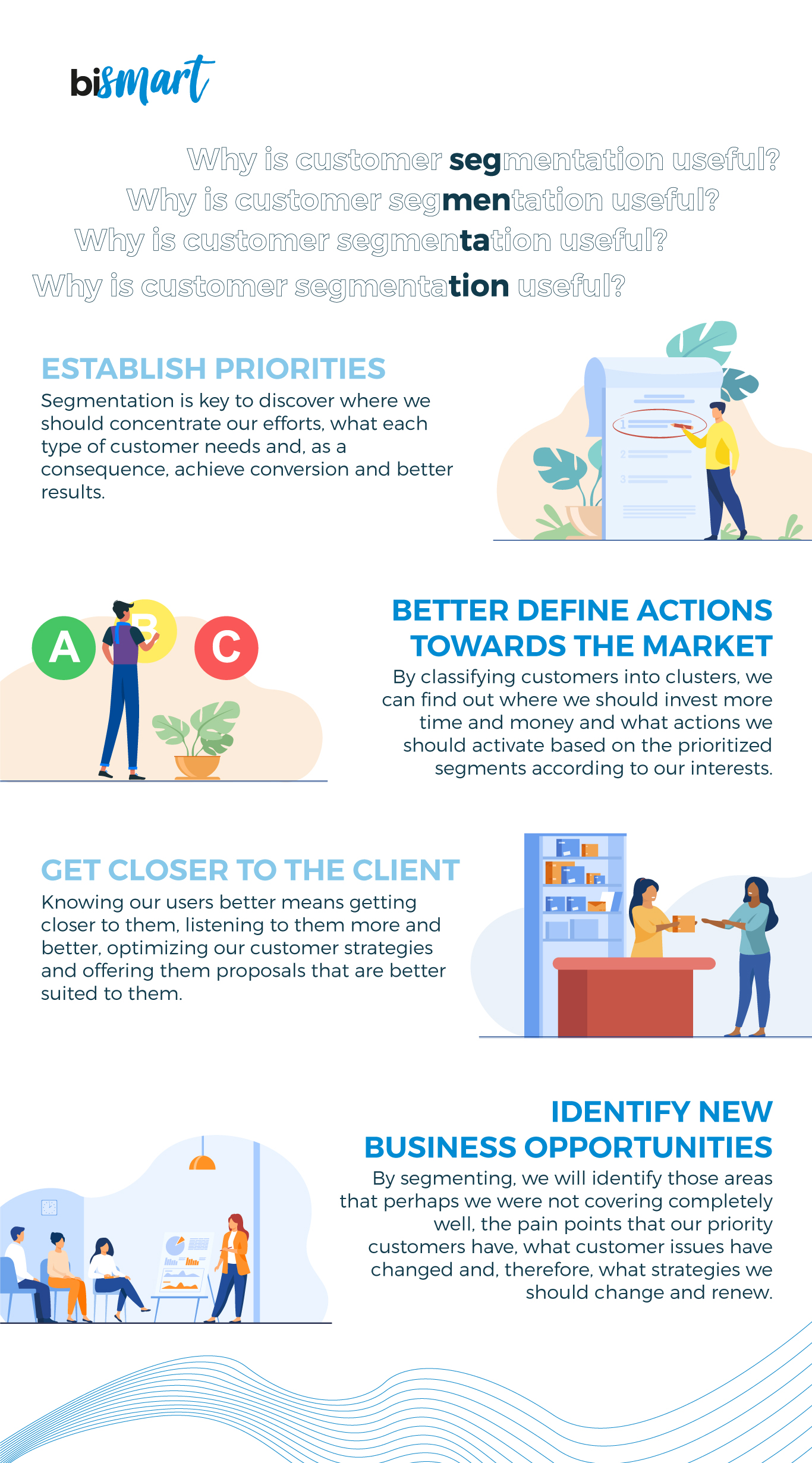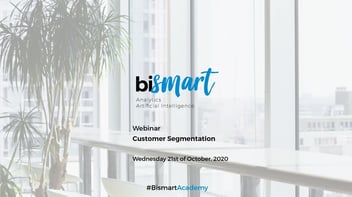We reflect on the value of customer segmentation to create a customer-centric business strategy. What is customer segmentation and how does it work?
Technology has transformed our world, it is undeniable. In the business world, this transformation has resulted, among other things, in an intensification of the dialogues between consumers and companies, as well as an increase in the customer's capacity for decision making and expression. Businesses have understood that listening to the customer means refining the experiences they provide and, therefore, optimizing their results. All of this has caused companies to radically change their focus, moving from viewing the world from a company-focused perspective to a customer-centric perspective.

What is customer centricity and why is it useful?
Customer centricity is, basically, a change of perspective that consists of focusing all business strategies and actions on the customer, starting with active and constant listening, as well as the incessant effort to know, understand and empathize with him/her.
This change has occurred as a result of circumstances because, today, it is no longer the companies that dictate what the user wants or needs, but it is now the customer who, indirectly, conditions the offer by stating their needs, desires and wills. Therefore, listening to them and responding to their warnings means success.
It is increasingly important to have a multi-panoramic understanding of our consumers. The general information - age, gender, profession, etc. - that was used to define and outline a portrait of who they are, is no longer sufficient. Now it is necessary to go a step further and explore their consumption and leisure habits, their hobbies and interests, the channels they use, their experiences as consumers, their pain points, their dissatisfactions... Not offering the client what he wants, how he wants it and in the conditions in which he requires it, will cause him to opt for another of the thousand options that the market offers him; one that will listen and be interested in what he has to say.
In short, today it is the customer himself who demands us to create a customer-centric business strategy. In this sense, one of the fundamental bases of customer centricity is customer segmentation.
What is a customer-centric company?
A customer-centric company, also known as a customer-focused or customer-oriented company, is an organization that places its customers at the center of its business strategy, operations, and decision-making processes. The primary focus of a customer-centric company is to understand and meet the needs, preferences, and expectations of its customers in the best possible way.
Key characteristics of a customer-centric company include:
-
Customer Understanding: A customer-centric company invests time and resources in understanding its customers' preferences, pain points, and behaviors. This understanding is often achieved through customer surveys, feedback, market research, and data analysis.
-
Customer Experience: The company prioritizes delivering a positive and seamless customer experience at every touchpoint, whether it's during pre-purchase interactions, the purchasing process, or post-purchase support.
-
Personalization: A customer-centric company tailors its products, services, and marketing efforts to meet individual customer needs. It uses data and insights to provide personalized recommendations and offerings.
-
Continuous Improvement: Such companies continuously seek feedback from customers and use it to improve their products, services, and processes. They are open to change and adapt based on customer demands.
-
Customer Service: Excellent customer service is a core value of a customer-centric company. It ensures that customer inquiries and issues are addressed promptly and effectively.
-
Long-Term Relationships: Rather than focusing solely on short-term sales, a customer-centric company aims to build long-term relationships with its customers, fostering loyalty and repeat business.
-
Customer Advocacy: Customer-centric companies prioritize customer satisfaction and ensure that their employees, stakeholders, and business practices are aligned to serve the best interests of customers.
-
Customer-Centric Metrics: The company uses customer-centric metrics, such as customer satisfaction scores, Net Promoter Score (NPS), and customer retention rates, to measure and track its success in meeting customer needs.
-
Innovation and Product Development: A customer-centric company involves customers in the product development process, seeking their feedback and ideas to create products that genuinely address their needs.
By adopting a customer-centric approach, companies can build strong brand loyalty, gain a competitive advantage, and achieve sustainable growth in today's highly competitive and customer-driven business landscape.
What is customer segmentation?
Customer segmentation, therefore, consists of analyzing and organizing all the information we have about our customers, enriching it as much as necessary with external information and, based on this, classifying them into customer groups or clusters in order to subsequently make decisions based on these. Clusters are groups of clients that have homogeneous characteristics among themselves and that, in turn, present heterogeneous qualities with respect to the other segments.
This practice serves, essentially, to understand the different types of clients we have and to orient our actions to each one of them. In addition, it helps to place the client in the center since the process involves listening to him, classifying him and adapting business strategies to his needs. In other words, by segmenting, companies manage to develop strategies that are totally focused on each type of customer and, therefore, satisfy their needs better, improve their user experiences, etc. Segmentation also contributes to achieving conversion and leads to better business decisions that will now be conditioned by the defined variables of each of our customer groups.
Why is customer segmentation useful?
Basically, customer segmentation manages to offer each customer exactly what they want and need.
On the other hand, customer segmentation entails knowing our customers better, since, in order to classify them, it is necessary to carry out an individual exploration exercise -for each one- that forces us, for example, to determine which variables allow us to categorize them better or to collect additional information that perhaps we did not know. In relation to this, customer segmentation has evolved the same way information and big data have. General data - age, gender, profession, etc. - that were previously used to define and profile a portrait of who they are, are no longer sufficient. It is now necessary to go a step further and explore more specific aspects such as their consumption and leisure habits, their hobbies and interests, the channels they use, their experiences as consumers, their behavior, their pain points, their dissatisfaction, their use of channels and devices, data related to the SAC and the customer journey, etc.
Segmentation is also oriented towards differentiation. In the words of Borja Martin, "the final purpose of segmentation is to promote actions that help us differentiate ourselves from the competition." In other words, if we carry out this exercise it is, precisely, to be able to develop innovative, original and differentiated actions from those carried out by our competition and which, in turn, are adapted to the different types of clients we have. In relation to this, it is convenient to create our own segmentations beyond the automatic ones that, for example, Google, Amazon or Facebook provide. "If we use these segmentations and do not use added information, we run the risk of making little difference."
To obtain this information, it is essential to carry out a data integration process that allows us to have all the information integrated and united, analyze it (data analysis) and complete it. Only in this way, segmenting will be effective and we will be able to make decisions based on the data (data-driven decisions).
What are the types of customer segmentation?
There are a lot of ways to segment such as client ABC, client scoring, etc. Some of the most recurrent are:
- Lifecycle segmentation: Customers are classified into age groups and variables related to the needs and behavior of each age subgroup are determined. An 18 year old person probably does not have the same economic possibilities or the same work status as a 40 year old person. This is just an example of how variables related to the age or lifecycle of clients can be determined.
- RFM (Recency, Frequency, Monetary): The RFM model is based on classifying customers according to three variables: Recency -the last time the customer had contact with the company-, Frequency -frequency of customer consumption with respect to my brand- and Monetary -customer spending-. It is a transactional analysis based on investigating how our customers relate to us in a more complete way than other types of segmentations.
- Transactional segmentations: In this case, customers are classified by purchasing behavior. In other words, clusters are defined according to the products or services they buy, the times or frequency in which they buy, the amount they usually spend, the channels or devices from which they purchase the products and other specific criteria related to the business sector of each organization. For example, a hotel company could define clusters based on variables such as the type of room the customer stays in, whether they come on weekends, working days or vacations, how many days they stay, the services they request, etc.
- Behavioral segmentation: Users are segmented based on deeper variables related to their behavior: purchase habits, analysis of browsing patterns, content consumption, channels and means of consumption, etc.
Customer segmentation by Buyer Persona
Another way of segmenting, which deserves a separate section, is through the Buyer Persona system. This system consists of, once we have defined our clusters, humanizing them so that they stop being statistics and become portraits of our customers. This entails a further step in our efforts to understand and get to know the customer and involves acquiring an even greater understanding of their behavior, dissatisfactions, needs, interests, lifestyle, etc.
A buyer persona is, basically, our ideal customer. Obviously, once we are clear about the different customer segments we have, we know that we should not create a single buyer persona, but rather we should build several ideal customers according to our clusters. In general, companies tend to create between 3 and 8 buyer persona.
When creating a buyer persona, we must consider as many aspects as we can and, at a minimum, we should define their demographics, educational level, job and work situation, their interests, hobbies and leisure activities, their family situation, their social circles, their dissatisfactions and needs, as well as their beliefs, values, opinions and objectives. In addition, we should not limit ourselves to summarizing all these aspects in one word, but rather create a complete story for each of our types of buyers.
Regardless of the type of segmentation that we carry out, in order to obtain beneficial results, it is fundamental to base our analysis on quality data (data quality) about the users and to have historical data so that the information has a solid base.
The value of customer segmentation
Digitalization has transformed the connections between businesses and customers, increasing the consumer's decision-making capacity and forcing companies to execute their activity by placing the clients at the center: customer-centricity. Within this framework, segmenting is a necessary and indispensable process to develop strategies tailored to the needs, desires and peculiarities of customers.
In addition, segmenting means optimizing resources, since it contributes to stop making inconsistent or mistaken investments that do not provide any value to the user, and instead allocating resources to strategies that really satisfy their needs and provide benefits.
For all these reasons, segmenting contributes to strengthen the loyalty of our clients and, without a doubt, is beneficial for both the company and the user.
If you have any questions regarding customer segmentation, do not hesitate to contact us, we are here to help!

What technology do you need to be customer-centric?
When it comes to building a customer-centric strategy, technologies that help managing and deploying customer data are a must.
At the moment, Customer Data Platforms are the most complete customer data management technologies.

A Customer Data Platform (CDP) is the most advanced customer data management tool. Thus, it plays a crucial role in achieving a customer-centric perspective in a business. Here's why a CDP is useful in this context:
-
Unified Customer Data: A CDP collects and consolidates customer data from various sources and channels, such as website interactions, mobile apps, social media, emails, and more. By centralizing all this data, a CDP creates a unified customer profile, providing a comprehensive and real-time view of each customer's behavior and preferences.
-
360-Degree Customer View: With a unified customer profile, businesses gain a 360-degree view of their customers. This detailed understanding allows them to tailor products, services, and marketing efforts to meet individual customer needs, ultimately enhancing the overall customer experience.
-
Personalization: A CDP enables businesses to deliver personalized experiences at scale. By leveraging the customer data and insights, companies can provide relevant content, product recommendations, and targeted marketing messages, increasing customer engagement and satisfaction.
-
Real-time Insights: A CDP processes data in real-time, allowing businesses to respond quickly to customer interactions and behavior. This agility enables timely responses to customer inquiries, concerns, or opportunities, resulting in improved customer service and increased customer loyalty.
-
Segmentation and Targeting: By analyzing customer data, a CDP enables businesses to create customer segments based on various attributes, behaviors, or preferences. This segmentation facilitates targeted marketing campaigns and promotions, optimizing the effectiveness of marketing efforts.
-
Customer Journey Mapping: A CDP helps businesses understand the customer journey, from initial contact to conversion and beyond. This insight allows companies to identify pain points and opportunities for improvement, leading to a smoother and more satisfying customer experience.
-
Data Privacy and Compliance: A reputable CDP ensures data privacy and compliance with relevant regulations. With increasing concerns about data security and privacy, a CDP provides the necessary tools to manage and protect customer data responsibly.
-
Cross-Channel Consistency: A CDP ensures consistency in customer interactions across various channels and touchpoints. Whether a customer engages through a website, mobile app, email, or physical store, a CDP helps maintain a coherent and seamless experience.
-
Data-Driven Decision Making: By providing deep customer insights and data-driven metrics, a CDP empowers businesses to make informed decisions. These decisions can range from product development and marketing strategies to customer support improvements, all aimed at delivering better customer experiences.
In summary, a Customer Data Platform is instrumental in achieving a customer-centric perspective in a business by centralizing customer data, providing a comprehensive customer view, enabling personalization, facilitating real-time interactions, and supporting data-driven decision-making. It helps businesses create more meaningful and relevant customer experiences, leading to increased customer satisfaction, loyalty, and long-term success.
Discover the hidden power behind CDPs and why they have become the top technology investment for leading companies in the market. Unravel all the essential insights about Customer Data Platforms in our complimentary e-book: "CDP: A Step Closer to Customer Centricity".



